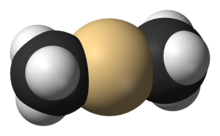Dimethylcadmium is the organocadmium compound with the formula Cd(CH3)2. It is a colorless, highly toxic liquid that fumes in air. It is a linear molecule with C-Cd bond lengths of 213 pm.[1] The compound finds limited use as a reagent in organic synthesis and in metalorganic chemical vapor deposition (MOCVD). It has also been used in the synthesis of cadmium selenide nanoparticles, although efforts have been made to replace it in this capacity due to its toxicity.[2]

| |
| Identifiers | |
|---|---|
3D model (JSmol)
|
|
| ChEBI | |
| ChemSpider | |
| ECHA InfoCard | 100.007.324 |
| EC Number |
|
PubChem CID
|
|
| UNII | |
CompTox Dashboard (EPA)
|
|
| |
| |
| Properties | |
| C2H6Cd | |
| Molar mass | 142.484 g·mol−1 |
| Appearance | Colorless liquid |
| Odor | Foul; unpleasant; metallic; disagreeable; characteristic |
| Density | 1.985 g/mL |
| Melting point | −4.5 °C (23.9 °F; 268.6 K) |
| Boiling point | 106 °C (223 °F; 379 K) |
| Reacts with water | |
| Hazards | |
| Occupational safety and health (OHS/OSH): | |
Main hazards
|
Extremely toxic, reacts with water to release methane |
| GHS labelling: | |
  
| |
| Danger | |
| H225, H250, H252, H260, H301, H330, H350, H360 | |
| P101, P102, P103, P222, P231, P301+P310, P303+P361+P353, P305+P351+P338, P403+P233, P422, P501 | |
| NFPA 704 (fire diamond) | |
| Flash point | 18 °C (64 °F; 291 K) |
| Related compounds | |
Related compounds
|
|
Except where otherwise noted, data are given for materials in their standard state (at 25 °C [77 °F], 100 kPa).
| |
Dimethylcadmium is prepared by treating cadmium dihalides with methyl Grignard reagents or methyllithium.[3]
- CdBr2 + 2 CH3MgBr → Cd(CH3)2 + 2 MgBr2
The same method was used in the first preparation of this compound.[4]
Dimethylcadmium is a weak Lewis acid, forming a labile adduct with diethyl ether. A yellow, air-sensitive adduct is formed with 2,2'-bipyridine.[3]
References
edit- ^ Felix Hanke; Sarah Hindley; Anthony C. Jones; Alexander Steiner (2016). "The Solid State Structures of the High and Low Temperature Phases of Dimethylcadmium". Chemical Communications. 52 (66): 10144–10146. doi:10.1039/c6cc05851e. PMID 27457504.
- ^ Julia Hambrock; Alexander Birkner; Roland A. Fischer (2001). "Synthesis of CdSe nanoparticles using various organometallic cadmium precursors". Journal of Materials Chemistry. 11 (12): 3197–3201. doi:10.1039/B104231A.
- ^ a b Douglas F. Foster; David J. Cole-Hamilton (1997). "Electronic Grade Alkyls of Group 12 and 13 Elements". Inorganic Syntheses. Vol. 31. pp. 21–66. doi:10.1002/9780470132623.ch7. ISBN 9780470132623.
- ^ Erich Krause (1917). "Einfache Cadmiumdialkyle (I. Mitteilung über organische Cadmium-Verbindungen)". Berichte der deutschen chemischen Gesellschaft. 50 (2): 1813–1822. doi:10.1002/cber.19170500292.
